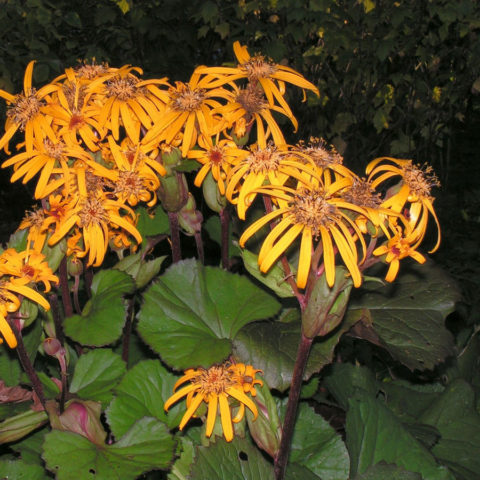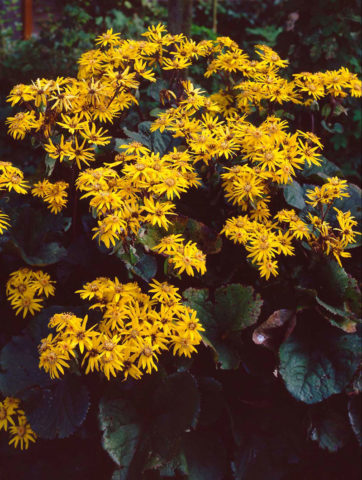Content
Buzulnik, or ligularia, is a perennial herbaceous flowering plant. It got its name, coming from the Latin ligula - “tongue”, because of the shape of the petals. Some plant species are actively used in gardening, including artificially bred varieties. One of them is the Othello buzulnik, which belongs to the Serrated species.

The plant captivates gardeners with its bright inflorescences
Description of the buzulnik Othello
The plant is large, up to 1 m in height. The leaves are large, glossy, with branched dark red veins and a purple border. When opened, they reach 40-50 cm. Incompletely blossomed leaves are purple-violet in color. Then they become dark green with a purple tint on top and purple below.
The flowers are large, orange-yellow. Their size is about 13 cm in diameter.
Flowering begins in late August - early September and lasts about one and a half months.
What are the differences between the buzulnik Othello and Desdemona
Buzulnik Othello and Desdemona are considered the most common varieties.They belong to the same variety - jagged buzulnik - and have much in common, but they also have differences. This applies to the color of leaves and inflorescences.

The Desdemona variety is slightly different from Othello, although it has many common characteristics
Othello's leaves are dark, rich green, with a purple tint, Desdemona's are delicate, light green on top and lilac on the back.

Othello's flowers are yellow-orange, Desdemona's are red-orange.
Application in landscape design
Buzulnik serrated Othello stands out for the bright colors of its inflorescences and the purple hue of its leaves. According to landscape designers, it looks ideal in groups with other plants, including representatives of its own species. It is used to decorate garden ponds, where it harmonizes with marsh irises and other varieties growing near the water. Thanks to the changing color of the leaves, you can see how the image of the garden changes at different times. Single copies also look impressive. It is used to decorate garden buildings and fences, as a hedge, and to create flower beds. In gardens in a natural or rustic style, buzulnik looks good, planted in groups of 3-5 copies. You can experiment by combining different varieties.
Features of reproduction
Buzulnik Othello is propagated in two ways:
- dividing the bush;
- seeds.
The first option is more often practiced as it is simpler and more reliable.
Propagation by seeds will take more time and effort, and it will bloom only after 4 years. The process includes collecting seeds in the fall after they are fully ripe, drying them, and pre-sowing preparation. Then they are sown immediately in open ground before winter, where they will undergo natural stratification.To avoid freezing, it is recommended to cover the plantings. You can sow the seeds in containers for seedlings and transplant them into open ground when the weather is relatively warm.
It is much easier to propagate buzulnik by dividing the bush. In this case, less labor will be spent, and the result can be admired the next year.
Buzulnik Othello can grow in one place for up to 15 years, but it is recommended to rejuvenate the plant every 5-7 years. To do this, the bush is dug up, divided into several parts and transplanted to a new location.
Planting buzulnik Othello
Planting buzulnik is not difficult, but there are nuances that you need to know about. It is planted with seeds directly into the ground or into containers for seedlings. An easier way is to plant a cutting taken from an adult bush.
Recommended timing
Sowing seeds in the ground is carried out in late autumn so that they overwinter in the ground. You can plant them in early spring, but they may not have time to gain strength, and as a result the plant will not be powerful and beautiful.
For seedlings, they are planted in containers at the end of winter. They are transferred to open ground when warm weather sets in and the soil temperature is at least +10 degrees.
The shoots, separated from the bush, are planted in the ground in the spring. You can divide the bush and plant sections after flowering, but the spring option is preferable.
Site selection and soil preparation
When choosing a place for planting, you need to take into account that it does not like direct sunlight and feels great in a shaded area: in the shade of a fence, house walls, tree crowns.It is advisable to plant Buzulnik Othello along a fence, in the background of a flower bed, near a garden pond or on the shore of a natural body of water. It looks good between the trees.
As for the soil, the plant is not too demanding on it. Ideally, it should be moist and rich in nutrients.

Buzulnik Othello can grow even on heavy clay soil without drainage, and tolerates temporary flooding without problems.
Landing algorithm
When propagating buzulnik by dividing the bush, the steps are as follows:
- Choose an adult healthy bush that has developed root shoots.
- To separate part of the plant, you do not need to dig up the entire bush. Using a shovel or other suitable tool, you need to carefully cut off the required fragment.
- Dig out the cut-off part, fill the resulting hole with nutritious soil and water it abundantly with water.
- Rinse the excavated fragment under running water, divide into sections so that each has at least one viable bud.
- Before planting, dig up the soil to the depth of a spade bayonet. Form holes measuring 40x40 cm at a distance of about 1 m from each other.
- Plant the prepared cuttings into the holes, straightening the roots. Cover with a soil mixture consisting of garden soil, superphosphate, humus and wood ash and water. The buds should be located above the surface of the ground.
Within a year, the Othello buzulnik, propagated by dividing the bush, can bloom.
Seeds are planted in autumn in open ground:
- Dig up the soil for planting to a depth of about 30 cm. Per 1 sq. m add fertilizer: 1 bucket of humus, 2 cups of wood ash, 1 cup of superphosphate. The soil must be moist.
- Form long grooves.
- Bury the seeds 1 cm, leaving a distance of about 1 m between them.If dense thickets are required, make gaps 0.5 m long. Moisten the planting site.
Features of care
Despite the fact that the buzulnik Othello is undemanding, he needs care, then he will always be strong and beautiful. The plant needs watering, fertilizing, loosening, mulching, and pruning. Tall specimens may require supports to tie them to to prevent them from breaking.
Watering and fertilizing schedule
Buzulnik Othello is a moisture-loving plant. Even the slightest drying out of the soil leads to slower growth of the bush and wilting of the leaves. The soil must be constantly moistened, so irrigation is required. In hot weather, you need to water as needed, without allowing the top layer of soil around the plant to dry out. In case of drought, it is necessary to spray - it is better to do this in the morning or in the evening, when there is no scorching sun. If the weather is moderately warm, you need to water once a week. If it's cool, there's usually plenty of precipitation. Young, recently planted bushes are watered once every 3-4 days. Watering should be plentiful, since the buzulnik has a rather long root.
Buzulnik Othello grows well in fertile soil rich in nutrients. The first time fertilizer is applied immediately after planting. It consists of wood ash, superphosphate, and humus. Then feed 1-2 times a year. In spring, cow manure diluted with water is added to the soil under the bushes. Next time, you can fertilize it with humus after flowering so that the buzulnik has the strength to survive the winter. When feeding, humus should not fall on the roots.
Loosening and mulching
It is desirable that the soil around the bushes be loose and provide oxygen access to the roots. This requires weeding.You can place mulch in the form of dry peat on the site, reducing the number of loosening procedures and ensuring longer moisture retention.
Trimming
Pruning is carried out after the buzulnik has faded.

If you need to get seeds, leave a few large inflorescences
Pruning is necessary to transfer nutrients from the inflorescences to the stems and leaves. The procedure helps to rejuvenate the plant.
Preparing for winter
Buzulnik Othello needs to be prepared for winter. Cold weather can harm the plant if there is little snow during frosts.
With the onset of the first frost, the above-ground part of the buzulnik is completely cut off, this area is mulched using dry peat and straw. In areas with cold winters, you need to cover it with spruce branches.
Diseases and pests
Buzulnik Othello is characterized by good health and resistance to pests and diseases.
As for pests, you should pay attention to slugs, which appear on the plant in spring and eat the leaves. To protect the buzulnik from this pest, the soil near the bush is sprinkled with superphosphate in granules for prevention. If slugs have already appeared, they must be collected manually.
It is not often possible to find powdery mildew on buzulnik. In this case, it must be treated with colloidal sulfur or a solution of potassium permanganate.
Conclusion
Buzulnik Othello is a spectacular plant that stands out for its unusual foliage and bright orange inflorescences. To provide it with the necessary care, it does not require much time and labor, since it is not picky. The main thing is to remember to moisturize and protect from the scorching rays of the sun.








